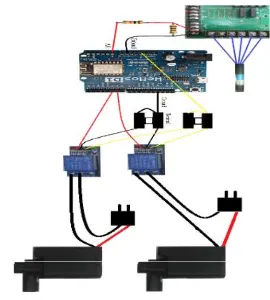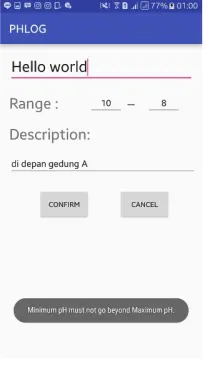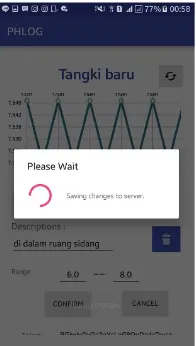IoT for Real Time Data Logger and pH Controller
Leo Willyanto Santoso, Andreas Kwariawan, Resmana Lim
Petra Christian University developing country. The absence of efficient wastewater management has caused serious environmental problems and cost issues. Therefore, in this paper IoT-based data logger and pH controller is proposed to reduce the inefficiency. IoT is a concept whereby objects around us can interact and exchange information with each other without human intermediaries through the Internet. One of the implementation of IoT is to monitor the level of liquid acidity through smartphones. It needs additional tools such as sensors, microcontrollers, and other devices that are then connected to the internet. Android-based mobile phone is used to interact with sensors, microcontroller, and other tools through the internet wherever the user is. From the testing, there is a successful communication between the components of the device, sensors, and Android devices. It is possible to adjust the acidity of the liquid automatically by activating the pump in accordance with the results of the pH readingKeywords- Internet of Things; microcontroller; acidity; monitor and controlling
I. Introduction
IoT or Internet of Things is a system whereby interrelated devices can exchange data over the Internet without requiring human-to-human or human-to-computer interaction [1]. Things in the Internet of Things can mean anything like a sensor-mounted chair, a heart monitor implant, or a vehicle with a sensor installed to alert tire pressure. Internet of Things uses objects with sensors to record data. The data obtained will be processed through a processor board or microcontroller. Microcontroller commonly used for IoT is RaspberryPi, Arduino, ESP8266 and others. The purpose of IoT is to get various data from around us as an analysis or reference that will be used for other purposes such as decision making, market analysis, or just observation.
The level of acidity in liquids can also be one of the objects for the Internet of Things. The level of acidity of fluid that we consume is very important for our health. Water that has an unbalanced acidity level will cause the environmental health and ecosystem to be disturbed. In addition, the level of fluid acidity also affects the analysis of a process or decision-making
for an industrial company. Liquid waste is liquid waste derived from the production from industry, household, or shops. Liquid waste that is not neutralized and disposed of will affect the ecosystem of the landfill. Fluids which have too high pH or too low can cause damage to both the drainage used, the container used, and the location used as the discharge of the liquid. One effort to manage liquid waste is to neutralize the pH or acidity levels.
Some industries and households do not pay attention to the impact of liquid waste on the environment. Effluent produced by an industry should meet the national guideline values of wastewater quality before it is released into rivers, streams or even municipal sewer systems. Management of liquid waste focuses on finding a way to dispose of the waste in a way that is safe for humans and the environment.
To solve the wastewater problems, this paper aims to design and implement an IoT for data logger and pH controller. The designed system is able to communicate with a variety of smart objects using Wi-Fi, Bluetooth and IrDA standards. As a result, all objects can exchange information through the designed system. The main contributions of this paper are as follows: (1) The designed IoT system enables the communication among different smart devices, including smart phones, microcontroller, and sensors. 2) The system provides solution to the wastewater management in order to know the acidity level of the liquid and help the pH setting using cutting edge technology.
The remaining part of this paper is organized as follows. Section 2 presents the background and the related work. Sections 3 presents the design of the IoT system and 4 present the testing of the proposed system. Finally, the conclusions are drawn in Section 5.
II. Related Work
A. Internet of Things (IoT)
B. Ubidots Cloud Platform
Ubidots is a server that can be used for the implementation of the Internet of Things. Ubidots helps for the process of cloud implementation. Ubidots provides APIs to help with the data collection process and make it informational. API is a way or solution for objects to interact with the web. This API allows makers to make changes and retrieval data from the server. This API supports both HTTP and HTTPS usage. To exchange data required API key. To retrieve a value or variable from the server then required the ID of that variable and the user account tokens that the server has given. To facilitate Android developers, Ubidots has provided a library that works to shorten the writing of HTTP requests in JAVA [10]. Ubidots has been used in several IoT-based system, for example for health management system [11], smart home [12, 13] and for environmental monitoring system [14].
C. Arduino IDE
Arduino IDE is an open-source software that helps create scripts or code and upload the script or code on the board or microprocessor. Arduino IDE has an environment written in Java. The Arduino IDE also has a compiler for C or C ++ languages. Arduino IDE does have a major function to help create scripts or code for various boards or microprocessors [15].
D. Microcontroller
Microcontroller is a microprocessor that has additional parts that make it possible to organize or control other objects. It can be interpreted that the microcontroller run programs that have been created by the user and stored in memory. Microcontroller is a very useful tool that can help the designer to manipulate data obtained from input or output. Usually microcontroller is composed of microprocessor, memory and I/O. The microprocessor itself is composed of Central Processing Unit (CPU) and Control Unit (CU). CPU is the main brain that performs arithmetic and logic processes. While CU controls the operation of the microprocessor and sends signals to other parts of the microprocessor to perform instructions [16].
III. System Design and Implementation
Schematic design is used to explain how to install the device. The schematic design can be seen in Figure 1. The output of the transmitter will be received by microcontroller with analog pin A0. The input included is a positive flow while the negative flow of the transmitter will be attached to the ground pin of the microcontroller. Positive and negative current flows are connected to a 100 ohm resistor.
Positive flow is given an additional 10K ohm resistor to anticipate if there is too large flow undesirable and can damage microcontroller. Terminals are used to make GND (ground) pins and 3V3 pins (3.3 volts) can be used by 2 different relays. Then the IN pin on each relay is paired on different digital pins.
Fig 1. Schematic Design
Use case diagram was used to create Android applications. It can be seen in Figure 2. The apps has some features such as signing in, signing up, and adding device to add new pH meter. There is a feature to set pH limits per device and setting about device information or delete device. Moreover, there is a pH statistics to see statistics of data from device which is selected, and view monthly average statistics to see pH statistics at each pH meter per month. To use existing features must be successful sign in or sign up first.
Fig 2. Use Case Diagram for Apps
Creating database on Android app using SQLite. The database is used to store data both from the server and from user input. The database is used to store user account information such as tokens and devices that have been created by the user using the account and the data on the device. The used ERD is shown in Figure 3.
IV. Testing
This section discusses the system testing of the IoT-based program. System testing is done by doing the process. The purpose of system testing is to know whether the program can perform well and in accordance with needs
First, device should be added to the system. Add device works to add new device and stored in server and android database. This page can be accessed by the user by pressing the "+" button. The add device page can be seen in Figure 4.
Fig 4. Add Device Interface
Users must enter device name, minimum range, maximum range, and description for every new device. If the user does not fill one of the fields then the application will display the alert or error message. Moreover, if the minimum range is filled over the maximum range then the app will display the alert as shown in Figure 5.
Fig 5. Alert when the minimum level over the maximum level If all the fields are filled and the user confirms the add device then the app will try to connect with the server and display the progress dialog as shown in Figure 6.
Fig 6. Progress dialog - check the connection to server
If the connection is successful then device creation will continue. The application will display the progress dialog as shown in Figure 7. After that the user will be redirected back to the main page.
Fig 7. Process of Variable Creation
If the connection fails then the application will display the alert/error message.
Fig 8. Interface of Manage Device and View Data
Users can change the description, minimum range, and maximum range. If one of the descriptions, minimum range, or maximum range is not filled then the application will display the alert as in Figure 9.
Fig 9. Alert if field is empty
If all the fields are filled and the user press the "confirm" button then the application will display the progress dialog as shown in Figure 10.
Fig. 10. Progress Dialog Edit Device
If the user pressed the delete button then the dialog box will appear as shown in Figure 11.
Fig. 11. Delete Confirmation Dialog
Users can remove the device by pressing "confirm" then the application will bring up the progress dialog as in Figure 12. Then the user will be directed to the main page.
Fig. 12. Delete Progress Dialog
The input on the microcontroller of the sensor is a bit. To be able to calculate the pH of the obtained bit value, it requires a solvent which have a known pH value. The solution used by the author has pH 4.01 and 6.86. The results of the measurement experiment can be seen in Table I. Equation (1) is used to calculate the pH.
TABLE I. EXPERIMENT OF PHMEASUREMENT WITH KNOWN SOLVENT
pH Bit
4.01 245
pH = M * <known bit> + C (1)
The value of M and C variables from equation 1 can be seen in Table II. 245) = -3.58. From the experimental results it can be concluded that the equation used is pH = (0.031 * <bit read result>) - 3.58. The comparison of the result of the line equation with the original pH can be seen in Table III.
TABLE III. THE RESULT OF LINEAR EQUATION WITH KNOWN PH
pH Bit Calculation Error
4.01 245 4.015 0.005
6.86 337 6.867 0.007
The pH control is performed when the sensor readout results out of a predetermined range of users through the Android app and the microcontroller will power the pump for 1 second. The pH control is done by using vinegar water to lower the pH and soap water to raise the pH level.
V. Conclusion
From the implementation of IoT for real time data logger and controller level of acidity of liquid waste using microcontroller and Android, can be drawn conclusion include: Android can interact with microcontroller by using Ubidots server as an intermediary. Application helps control process by setting pH limit setting. Microcontroller can control fluid pH by using pumps. Applications may warn that the pH has exceeded the specified limit. These devices are low cost, more efficient and capable of processing, analyzing, sending the data, and it can be viewed everywhere. The application is numerous and can be further developed to integrate more sensors which are applicable to monitor the quality of the environment.
References
[1] A. McEwen and H. Cassimally, Designing the Internet of Things, West Sussex: John Wiley & Sons, 2014.
[2] J. Tan, S.G.M. Koo, "A Survey of Technologies in Internet of Things", IEEE International Conference on Distributed Computing in Sensor Systems (DCOSS), 2014, pp. 269-274, 2014.
[3] K.A. Al Rabaiei and S. Harous, "Internet of things: Applications and challenges", 12th International Conference on Innovations in Information Technology (IIT), 2016, pp. 1-6, 2016.
[4] S. Agrawal and M. Lal Das, “Internet of Things — A paradigm shift of future Internet applications”, 2011 Nirma University International Conference on Engineering (NUiCONE).
[5] Y. Liu and G. Zhou, “Key Technologies and Applications of Internet of Things”, Int. Conf. on Intelligent Computation Technology and Automation (ICICTA), 2012.
[6] L. Xu, W. He, and S. Li, "Internet of Things in Industries: A Survey",
IEEE Transactions on Industrial Informatics, 2014, vol. 10, pp.
2233-2243.
[7] S.A. Jaishetty, and R. Patil, “IoT Sensor Network Based Approach for Agricultural Field Monitoring and Control”, IJRET, Vol:05 Issue:06, June 2016.
[8] D. Lu and T. Liu, “The application of IOT in medical system”, International Symposium on IT in Medicine and Education (ITME), 2011.
[9] K. Ullah, M.A. Shah, and S. Zhang, "Effective ways to use Internet of Things in the field of medical and smart health care", International Conference on Intelligent Systems Engineering (ICISE), pp. 372-379, 2016.
[10] Ubidots, "REST API Reference," 1 April 2016. [Online]. Available: https://ubidots.com/docs/api/#what-is-a-restful-api. [Accessed 15 Agustus 2016].
[11] S. Siddagangaiah, “A Novel Approach to IoT Based Plant Health Monitoring System”, International Research Journal of Engineering
and Technology (IRJET), Volume: 03 Issue: 11, Nov-2016.
[12] S.C. Babu and A.L. Siridhara, Energy Efficient Home Automation System, D.V., IJSRD-International Journal for Scientific Research &
Development, Vol. 4, Issue 04, 2016.
[13] D. Wang, D. Lo, J. Bhimani, and K. Sugiura, "AnyControl -- IoT Based Home Appliances Monitoring and Controlling", IEEE 39th Annual Computer Software and Applications Conference (COMPSAC), vol. 3, pp. 487-492, 2015.
[14] V.Anupriya, A.Manimozhi, D.Nivetha, and P.Nivethitha, “Smart Environmental Monitoring System Using Labview”, International
Journal Of Engineering and Computer Science, Volume 6 Issue 3
March 2017, pp. 20705-20709.
[15] Arduino, "Arduino - Environment," Arduinoo, 7 September 2015. [Online]. Available: https://www.arduino.cc/en/guide/environment. [Accessed 10 Agustus 2016].



